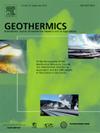Impact of groundwater flow on thermal response tests in heterogeneous geological settings
IF 3.5
2区 工程技术
Q3 ENERGY & FUELS
引用次数: 0
Abstract
This study investigates thermal response tests (TRTs) in heterogeneous geological settings to assess the impact of groundwater flow on TRT interpretation and borehole heat exchanger (BHE) performance. Traditional TRT analysis relies on the infinite line source (ILS) model, which assumes homogeneous ground and negligible groundwater flow. However, these assumptions are often lacking in natural environments, resulting in an overestimation of the thermal conductivity. The analysis of four distributed thermal response tests (DTRTs) in high groundwater flow regimes reveals apparent thermal conductivities up to 40 times higher than expected, highlighting the limitations of the ILS method in such settings. To address this issue, a comparison between the ILS model and the moving infinite line source (MILS) model, which accounts for advective heat transfer due to groundwater flow, was conducted. Model fitting and parameter optimization were performed on 84 temperature perturbation time series distributed along four BHEs used for TRT. The MILS model (global RMS = 0.25 °C) outperforms the ILS model (global RMS = 0.48 °C) in TRT data fitting and better reflects actual thermal conductivity values obtained from laboratory tests and literature. The MILS model also estimates groundwater flow velocities up to 3.0 × 10–5 m/s. Considering the estimated thermal conductivity and groundwater flow velocity, it was found that advective heat transfer contributes to 35–44 % of the total thermal exchange potential for all BHEs. A correction procedure for the apparent thermal conductivity derived from the ILS model, considering Darcy flow velocity, is presented using nomograms. This correction is crucial for accurate BHE design in areas with significant groundwater flow, ensuring a better understanding of BHE performance and its implications for shallow geothermal energy applications.
非均质地质条件下地下水流动对热响应试验的影响
本研究研究了非均质地质环境下的热响应测试(TRT),以评估地下水流动对TRT解释和钻孔热交换器(BHE)性能的影响。传统的TRT分析依赖于无限线源(ILS)模型,该模型假设地面均匀且地下水流量可忽略不计。然而,在自然环境中往往缺乏这些假设,导致对导热系数的高估。在高地下水流量条件下,对四个分布式热响应测试(dtrt)的分析显示,表观热导率比预期高40倍,突出了ILS方法在这种情况下的局限性。为了解决这一问题,将ILS模型与考虑地下水流动对流换热的移动无限线源(MILS)模型进行了比较。对84个温度扰动时间序列进行了模型拟合和参数优化。在TRT数据拟合方面,MILS模型(全局RMS = 0.25°C)优于ILS模型(全局RMS = 0.48°C),更好地反映了实验室测试和文献中获得的实际导热系数值。MILS模型还估计地下水流速高达3.0 × 10-5米/秒。考虑到估算的热导率和地下水流速,发现对流换热对所有BHEs的总热交换势贡献了35 - 44%。在考虑达西流速度的情况下,提出了一种利用图对ILS模型的视热导率进行校正的方法。这一修正对于在地下水流量较大的地区进行精确的BHE设计至关重要,确保更好地了解BHE性能及其对浅层地热能应用的影响。
本文章由计算机程序翻译,如有差异,请以英文原文为准。
求助全文
约1分钟内获得全文
求助全文
来源期刊

Geothermics
工程技术-地球科学综合
CiteScore
7.70
自引率
15.40%
发文量
237
审稿时长
4.5 months
期刊介绍:
Geothermics is an international journal devoted to the research and development of geothermal energy. The International Board of Editors of Geothermics, which comprises specialists in the various aspects of geothermal resources, exploration and development, guarantees the balanced, comprehensive view of scientific and technological developments in this promising energy field.
It promulgates the state of the art and science of geothermal energy, its exploration and exploitation through a regular exchange of information from all parts of the world. The journal publishes articles dealing with the theory, exploration techniques and all aspects of the utilization of geothermal resources. Geothermics serves as the scientific house, or exchange medium, through which the growing community of geothermal specialists can provide and receive information.
 求助内容:
求助内容: 应助结果提醒方式:
应助结果提醒方式:


